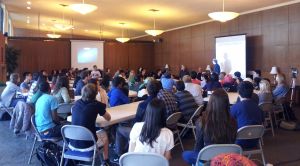Sense and Sensibility and Science is composed of lectures, discussion and lab sections, projects, and quizzes. The course has two main topics per week with a lecture and discussion section for each topic. For each topic, we have a detailed lesson plan with a sample lecture video, in-depth instructions for each discussion section, pre-made slides, examples, readings, activities, common misconceptions, data science modules, and more.
Lectures
Lectures are primarily used to provide students with their first introduction to the content of any given topic and give them a handful of examples to chew on. Some topics have activities in discussion section that are designed to integrate directly with the lecture. And a couple lectures are built around guest speakers (either one researcher in the case of 12.2 Grill the Guest or a panel of experts for 13.2 Deliberative Polling).
The course has been taught with anywhere from one to three professors giving pieces of each lecture. At UC Berkeley, there are typically three professors from physics, philosophy, and the social sciences that all engage with each other in a "plenary" session. In this format, parts of the lecture are reserved to have a freeform discussion where professors can use the expertise from their differing fields to build on each other and provide a richer view of each topic.
Discussion and Lab Sections
The sections are the core of the Sense & Sensibility & Science. Unlike most STEM classes where discussions provide a handful of practice problems that students can do on their own time, the discussions in SSS are a highly choreographed and critical component of the course. Each discussion section has a detailed lesson plan designed to actively engage the students in various activities, problems, and discussions that force them to wrestle with the topics in ways they couldn't on their own. These discussions emphasize the interdisciplinary nature of the course by taking advantage of the students' differing backgrounds and fields of study. They provide a framework to help students reach specific learning goals but are open-ended enough to give students the opportunity to teach each other.
Sections are best run in classrooms with seats that can be move around the room. Many universities have such rooms in their active learning classrooms or business/government schools.
Projects
The course has two main projects that take place over several weeks and give students the chance to integrate multiple course topics and apply them to different types of problems in the real world.
Project 1
The first project is a short report of 2000 words or less analyzing and contrasting three news/academic articles on the same topic. It is not an essay. Instead, it's more of a report/case study about how the ideas of this course disseminate in media.
Project 2
The second project involves applying the topics of the course to solve some problem. Each student creates a poster on a chosen topic with the aim of making a decision on some practical question. The question may be big or small, personal or societal, etc. At the end of the course, there is an optional poster presentation session held for extra credit.
Quizzes
The final piece of the course are the quizzes. These can take various forms depending on your needs. SSS has been taught with anywhere from just a midterm and a final to six quizzes spread out over the term. Practice quiz questions are released ahead of time so that students know what sort of misconceptions the questions are aiming to address. We have a bank of previously used quiz and exam questions available for different colleges and universities to build on.
